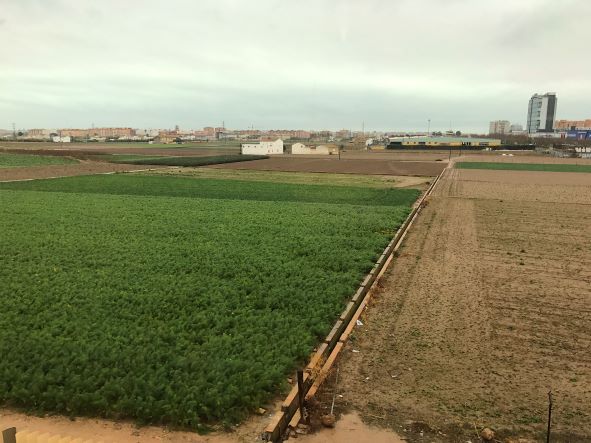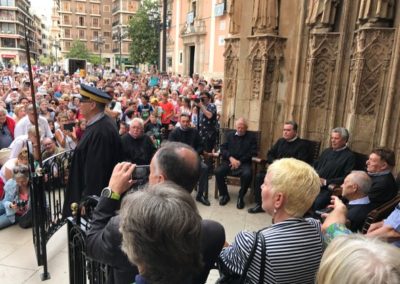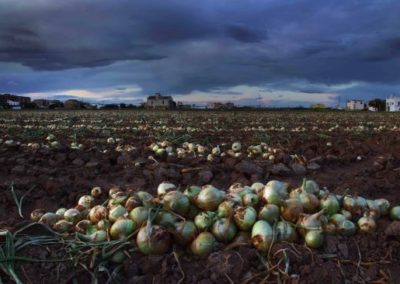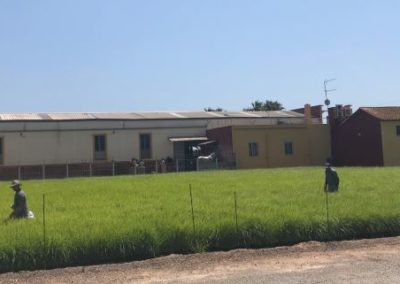The Orchard of Valencia
DOI: 10.5281/zenodo.7607488
Inland and Coastal Plains and Countryside Model
Authors: Sandra Mayordomo Maya and Mónica Fernández Villarejo
Overview of SAMUTER
The Huerta de València is one of the most important agricultural areas in the Mediterranean. It is located on the coastal plain of the central Valencian depression, situated between the south-eastern end of the Iberian reliefs and the Mediterranean Sea. It makes up the agricultural territory that surrounds the city of Valencia and the municipalities that make up its metropolitan area, irrigated by the seven irrigation channels of the Tribunal de las Aguas de la Vega de Valencia (Quarta-Benàger-Faitanar, Tormos, Mislata, Mestalla, Favara, Rascanya and Rovella), the Real Acequia de Moncada, the Acequia Real del Júcar and several historical springs and wells. It is an ancient landscape of exceptional value, harbouring environmental, cultural, historical, economic and social qualities of the highest order. This space is a landscape heritage that has become an image and a sign of identity for its inhabitants.
Irrigation is the defining and structuring element of this landscape, whose origin, as it is perceived today, dates back to the medieval Islamic period. Its hydraulic architecture is based on a recurrent system of dams located in the last stretch of the River Turia, main irrigation channels and secondary networks. The irrigation system is the axis from which the design and territorial planning of the Huerta has been produced, as the structure of the canals conditioned the distribution of the settlements and roads, as well as the cultivation plots. There are also other relevant components in the landscape articulation, such as the plot structure, the road network of historic paths, and the architecture that combines concentrated and dispersed habitat. However, the landscape of the Huerta is not only agricultural, but is made up of a mosaic of uses, where crops and traditional irrigation systems coexist with urban and industrial areas associated with the Valencian metropolitan area. A peri-urban landscape in which the cultivated area has been reduced in recent decades. The crops grown in the Huerta have varied throughout history. At present, horticultural products, citrus fruits, ornamental plants and rice predominate. Crop diversification, with a high number of local varieties, and the division of land into small plots, have been key to boosting the resilience of the site.
1. Environmental sustainability
The Huerta de València is one of the six thousand-year-old Mediterranean orchards that survive in Europe, according to the Dobris Report, carried out by the European Environment Agency. In recent years, the Valencian Government has promoted the Territorial Action Plan, PAT-2018 of the Huerta de Valencia. Likewise, in 2019 it was included in the register of Important Systems of World Agricultural Heritage (SIPAM), managed by the Food and Agriculture Organisation of the United Nations (FAO). Finally, its territory has two Natural Parks of relevant environmental value: the River Túria and L’Albufera, the latter also declared a RAMSAR Wetland, SCI and SPA.
The agri-food system of the Huerta de València is a space built by the superimposition of traditional knowledge and ways of life that have shaped its landscape. The irrigation system is the symbol of a secular domestication of the water resource to enable cultivation throughout the year. The hydraulic canals have been designed to irrigate by gravity, where water is distributed in a contiguous order of irrigation from the top of the system to the bottom. Their efficiency has enabled the development of sustainable agricultural techniques. Moreover, the imprint of the Muslim agronomic heritage on the design of canal networks is shown in the use of units of measurement such as the row or the Egyptian cubit. Farmers have kept irrigation systems in operation for centuries, and maintain exceptional craftsmanship techniques, such as the manufacture of traditional agricultural tools and implements.
The environmental values of the Huerta de València are significant and have favoured the development of irrigated agriculture, thanks to the availability of different types of resources: water, geomorphological, climatic and soil. The Huerta also has an important environmental function, with spaces without buildings, unsealed soils, atmospheric quality, and irrigation channels that mitigate torrential floods. It also acts as a green infrastructure by connecting nearby natural spaces. Flora and fauna species are numerous as a result of the variety of existing land uses and habitats. The diversity of crops, mainly fresh vegetables, is guaranteed by the quantity of local varieties, the availability of water from the traditional irrigation system, and the mosaic structure of the landscape, made up of small plots of land. In addition, the region has a certified organic farming area of 1,640 ha, and 228 companies are involved in this activity.
2. Territoriality and agri-environmental policies
The European Union establishes different differentiated quality regimes to protect certain agricultural products and foodstuffs. In this regard, Geographical Indications stand out, which establish intellectual property rights for certain products whose qualities are specifically linked to the area of production: Protected Designation of Origin (PDO), Protected Geographical Indication (PGI), and Geographical Indication (GI). Various products from the Huerta have these quality regimes. Thus, the production of tigernuts from the Huerta de Valencia is regulated by the DOP Chufa de Valencia, the highest distinction in terms of agri-food quality. Rice from Valencia, grown in the Albufera Natural Park and other wetlands, also receives this distinction. Finally, the PGI Valencia Citrus, which certifies those citrus fruits (oranges, mandarins and lemons) from Valencia that meet the requirements of guaranteed origin and quality, is also important.
3. Relations between production, processing, marketing and consumption
La Huerta de València provides healthy produce and economic livelihoods to local communities through 6,000 family farms and thousands of small plots. Approximately 80% of the area in production is dedicated to fresh fruit and vegetable crops, and the products obtained are destined both for family self-consumption and for commercialisation in local and municipal markets. The peri-urban condition of the Huerta has allowed for a close relationship between agricultural production and the city of Valencia, which is reflected in the traditional markets where farmers send their fresh produce directly to retail shops and municipal markets. Fresh agricultural production for local consumption allows the Huerta to be maintained as a unique landscape and as a complementary development strategy. Thus, this space is configured as one of the most important productive territories, whose success lies in the potential of the periurban environment of the city of Valencia, the main market for its products.
IIn the Huerta, the organisation of agri-food chains in networks stands out, where agricultural activity is configured as a strategic activity for the economic sustainability of families and irrigators. In this sense, the Tira de Comptar, an institution established in the 12th century that has guaranteed the supply of fresh produce to the city and the right of farmers to attend the market with their products and regulate their activity, is relevant. Since its foundation, this institution has had different locations, until its definitive establishment in Mercavalència, the largest agri-food centre in Valencia. Currently, the Tira de Comptar is a 6,000 m space where some 1,300 farmers from the Huerta de València (around 300 per session) come to market and sell their produce directly, between 30,000 and 40,000 tonnes of fruit and vegetables. 2 The uniqueness of this system is that each farmer sells the produce grown on his or her property so that the Tira is the shortest and most direct marketing channel. In 2017, the Aphorta label was introduced for crops grown by this institution, which also includes a traceability document. The farmers of the Huerta also have at Mercavalència the Ecotira, a space for direct sales of organic products that distributes the goods to professionals in the sector.
The Consell Alimentari Municipal de Valencia (CALM), a consultative and sectoral participation body of Valencia City Council, aims to promote a more sustainable, healthy and fair agri-food system, in line with the commitments adopted by the City Council with the signing of the Milan Urban Food Policy Pact. One of its main objectives is to promote agricultural production aimed at direct consumption through short marketing circuits.
4. Good governance
They are part of the so-called irrigation communities, which have their own ordinances (rules and regulations) for the resolution of problems between users. In addition, in the Huerta, the legal institution of the Water Tribunal, the oldest in Spain for resolving disputes over water use, was set up for the seven irrigation channels of the Vega. This age-old institution was inscribed in 2009 on UNESCO’s Representative List of Intangible Cultural Heritage of Humanity, and is responsible for enforcing its traditional rules for the distribution of water resources. In addition to dispensing justice, this body regulates the functioning of the irrigation system and allows the representatives of the acequias to make joint decisions and coordinate with the Real Acequia de Moncada.
In recent decades, the Huerta de València area has undergone significant socio-economic changes and territorial conflicts. Since the mid-20th century, urban and industrial pressure linked to the metropolitan dynamics has intensified, a process that has resulted in the loss of agricultural land. However, in recent years, Valencian society has equipped itself with instruments and tools for the management and conservation of the Huerta. With the articulation of recent legal initiatives, policies and landscape instruments, which emanate from the European Landscape Convention, new possibilities for the preservation of the Huerta are being considered. Thus, with the aim of halting the degradation of this space and promoting its protection and revitalisation, Law 5/2018, of 6 March, on the Huerta de València, came into force. This regulation contemplates the formulation of the Territorial Action Plan for the Planning and Revitalisation of the Huerta de Valencia (PAT), approved at the end of 2018, which is a supra-municipal planning tool that regulates the permitted uses and activities. The aforementioned Law also proposes the creation of the Huerta de Valencia Council, a management body responsible for drawing up the Agricultural Development Plan with the aim of revitalising agricultural activities and preserving this territory.
In addition to the PAT, in the Huerta de València area there is another territorial planning instrument, the Valencia Metropolitan Territorial Action Plan. Thus, the trend is towards the creation of a metropolitan territory with a new governance model based on cooperation and network collaborations. The development of different tools aimed at the preservation of the Huerta confirms the will of the territorial actors to recover agriculture as a productive activity, maintain the landscape, improve the food system, and share the experience with other areas.
The signing of the Milan Urban Food Policy Pact by Valencia City Council in 2015 has meant the start of a participatory process for the implementation of a Strategic Framework for Action. The Regional Ministry of Agriculture, Rural Development, Climate Emergency and Ecological Transition is leading this challenge and has developed the Integrated Action Plan for the promotion of the agricultural territory and agricultural activity. València was also named World Capital of Sustainable Food by the FAO in 2017.
València was the first city in Spain to establish a Municipal Food Council (CALM), promoted by the aforementioned Regional Ministry. It is a consultative and sectorial participation body of the València City Council, whose objective is based on promoting a more sustainable, healthy and fairer local agri-food system. It arose from a participatory process developed during 2016 and 2017, in which the territorial socio-economic agents linked to the local agri-food sector established the criteria for structuring an inclusive space for food governance. In this way, the CALM forms a significant forum for the participation of the different agents related to the Huerta de València, which integrates the public, private, academic and civil society sectors, as well as all the political parties, making it an innovative example of governance. This body, formally established in 2018, guides its action based on the commitments and contents of the Valencia Agrifood Strategy 2025. Other formal spaces for the coordination of public policies linked to the local agri-food system are the Valencian Observatory for Local Sustainability and the Municipal Coordination Board. In addition, València is a member of the Network of Cities for Agroecology (2017) and the Intervegas Pact (2018), and since 2019 it has been the headquarters of the FAO World Centre for Sustainable Urban Food. Finally, the Huerta de València has a relevant background of social struggle for its conservation and territorial protection.





Recent Comments